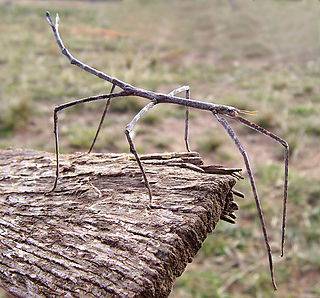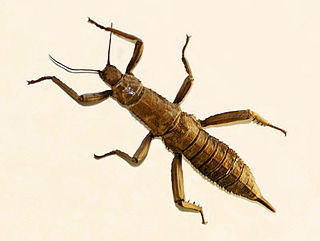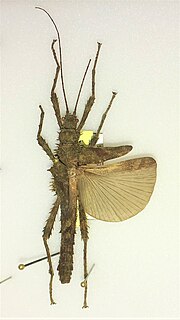
The family Phylliidae contains the extant true leaf insects or walking leaves, which include some of the most remarkably camouflaged leaf mimics (mimesis) in the entire animal kingdom. They occur from South Asia through Southeast Asia to Australia. Earlier sources treat Phylliidae as a much larger taxon, containing genera in what are presently considered to be several different families.

Extatosoma is a genus of phasmids, in the monotypic subfamily Extatosomatinae, with two species. One occurs in Australia, one in New Guinea. Both have a colour morph imitating leaves, and one imitating lichen.

Agathemera is a genus of stick insects in the suborder Euphasmatodea and superfamily Pseudophasmatoidea. It consists of several species limited to the mountainous regions of Argentina, Chile and Peru.

The Euphasmatodea, also known by its junior synonym Verophasmatodea is a suborder of the Phasmatodea, which contains the vast majority of the extant species of stick and leaf insects.

The Phasmatinae are a subfamily of stick insects in the family Phasmatidae. They contain at least three tribes; Bradley and Galil corrected the spelling to "Phasmatinae" and provides a key to tribes.

Necrosciinae is a subfamily of the stick insect family Lonchodidae, with its greatest diversity in South-East Asia.

Palophinae is a subfamily of the stick insect family Diapheromeridae. They belong to the superfamily Anareolatae of suborder Verophasmatodea.

Eurycantha is a genus of stick insects belonging to the family Phasmatidae. It was described by Jean Baptiste Boisduval in 1835.
Charmides cerberus, is a species of phasmid or stick insect of the monotypic genus Charmides. It is endemic to Sri Lanka.

Diapheromera is a genus of stick insects in the family Diapheromeridae. There are about 14 described species in Diapheromera.

Pseudosermyle is a genus of walkingsticks in the family Diapheromeridae. There are more than 20 described species in Pseudosermyle.

Necroscia is an Asian genus of stick insects in the family Diapheromeridae and subfamily Necrosciinae. Species have been recorded from South-East Asia.

Pachymorphinae is a subfamily of stick insects in the family Diapheromeridae. Genera are primarily found in Africa, Asia and Australia.

Phasmatini is a tribe of stick insects in the family Phasmatidae. There are more than 40 described species, found in Australasia, Asia and possibly Brazil.

Megacrania is a genus of the subfamily Megacraniinae of stick insects. Members of this genus are commonly referred to as "peppermint stick insects", due to the characteristic odor of their defensive spray, as well as the cylindrical, twig-like shape of their bodies.

The Platycraninae are an anareolate subfamily of stick insects in the family Phasmatidae. Their known distribution includes southern, southeast Asia and Australasia.

Platycrana is the type genus of the reconstituted subfamily Platycraninae: which are stick insects from the Asia-Pacific region. They belong to the monotypic tribe PlatycraniniBrunner von Wattenwyl, 1893. There is a monotypic species: Platycrana viridana(Olivier, 1792): originally described as "Mantis viridana" Olivier AG, with the type locality in the Moluccas.
Pachymorpha is a genus of phasmids belonging to the family Diapheromeridae.

Haaniella is a genus of the Phasmatodea family Heteropterygidae from Southeast Asia.

Miroceramia is a monotypic genus of stick insects, containing Miroceramia westwoodii as the only described species. It is the only fully winged one of the subfamily Obriminae.
















